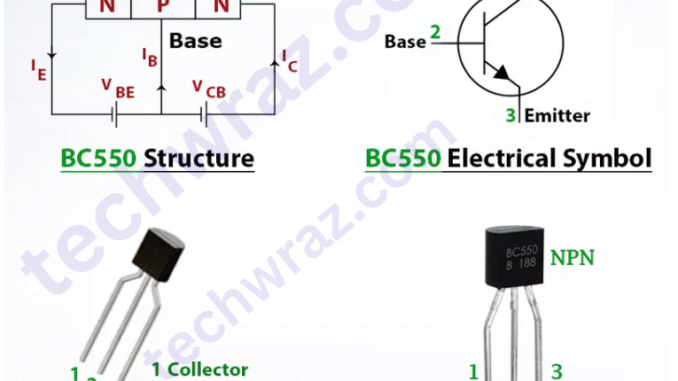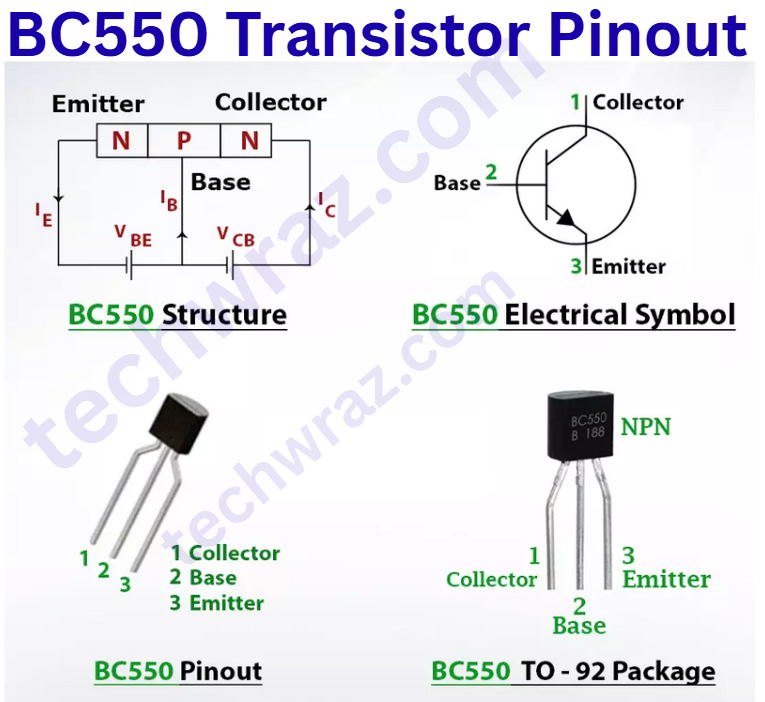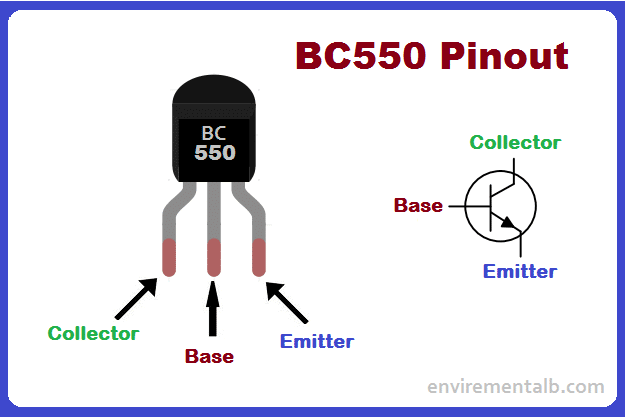
The BC550 transistor is a general-purpose BJT transistor of the BC547 series. The transistors in this series are commonly used for wide-purpose applications in commercial devices and also in academic and hobby electronic projects. This transistor can be used for both switching and amplification. When used as a switch, it can control a load up to 100 mA. The max collector dissipation is 500 mW, and the maximum DC current gain value is 800 mW, so it can also be used as a preamplifier or signal amplifier. The BC550 is made in different (hFE) values, which can be determined by the last alphabet used after the transistor number if the last alphabet is “A,” the (hFE) value will be 110 – 220; if “B,” the (hFE) value will be 200 – 450; and if “C,” then the (hFE) value will be 420 – 800.
Pinout of BC550 Transistor
The pinout detail of the transistor BC550 is given below in the pictures.
Features of BC550:
- Type of Package – TO-92
- Noise Figure—1.2 dB
- Collector Current: 0.1 A
- Type of—NPN
- Collector & Emitter Voltage: 45 volt
- Collector the Base Voltage: 50 volt
- Emitter the Base Voltage: 5 volt
- Transition Frequency—150 MHz
- Collector Dissipation—0.5 Watt
- DC Current Gain (hfe) – 110 – 800
- Operating and Storage Junction Temperature Range -65 to +150 °C
A complement of NPN transistor
The complement of the BC550 transistor is the BC560.
BC550 Equivalent:
The alternates of BC550 are BC847, BC850 (SOT-23), BC847W (SOT-323), and BC850W (SOT-323).
Replacement transistor for the BC550
The replacements for BC550 are BC546 or BC547
How We Can Use It:
BC550 transistors can be used in this type of general application. If we use it as a switch, then we should drive a load of 100 mA. Which is enough current to drive microcontrollers, LEDs, relays, ICs, power transistors, portions of a circuit, etc.? The emitter-base voltage is only 5 volts, so it can also be used at the output of the microcontroller to operate loads. On the other hand, it can also be used as an amplifier for audio and other small signals. Furthermore, this transistor can also be used as a preamplifier or audio preamplifier for any small electronic signals.
Applications of BC550 Transistor:
- Signal Amplification
- Audio Preamplification
- Switching Loads Under 100 mA
- Audio Amplification
- Microcontrollers Output
- Darlington Pairs
How to Safely Long Run in a Circuit:
To get long performance from transistor BC550, it is recommended to not operate a load more than 100 mA and 45 volts. Always use a suitable base resistor to procure the required base current to the transistor. The BC550 transistor is also projected using the transistor in the recommended temperature that is more than -65 degrees centigrade and below 150 degrees centigrade.
BC550 vs 3904:
Here’s a comparison table between the BC550 and 2N3904 transistors, covering their key specs and differences:
| Specification | BC550 | 2N3904 |
|---|---|---|
| Type/Polarity | NPN small-signal transistor Futurlec+1 | NPN general-purpose transistor |
| Maximum Collector-Emitter Voltage | ~ 45 V | ~ 40 V Flex PCB+1 |
| Maximum Collector-Base Voltage | ~ 50 V | ~ 60 V |
| Maximum Collector Current | ~ 100 mA | ~ 200 mA GO+1 |
| Power Dissipation | ~ 500 mW | ~ 625 mW Flex PCB |
| Transition Frequency | ~ 300 MHz | ~ 300 MHz AIChipLink |
| Intended Use | Low-noise amplifier, small signal stages | General purpose switching & amplification DatasheetGO |
| Noise Characteristics | Low-noise optimized version among BC series | Typical general-purpose; not specialized for ultra-low noise |
| Summary Strengths | Better for low-noise / amplifier front-ends; decent voltage rating | Higher current capability; very common and widely available |
BC550 Datasheet: Click


